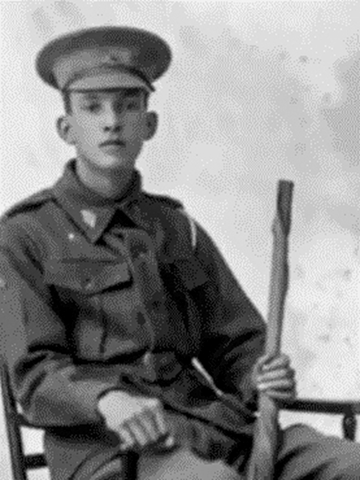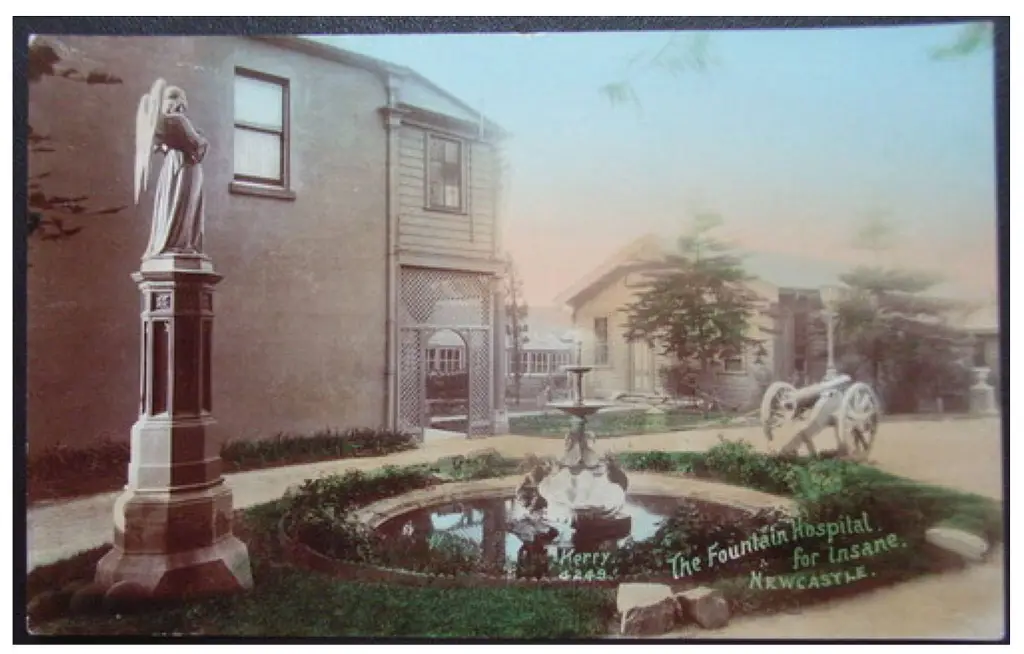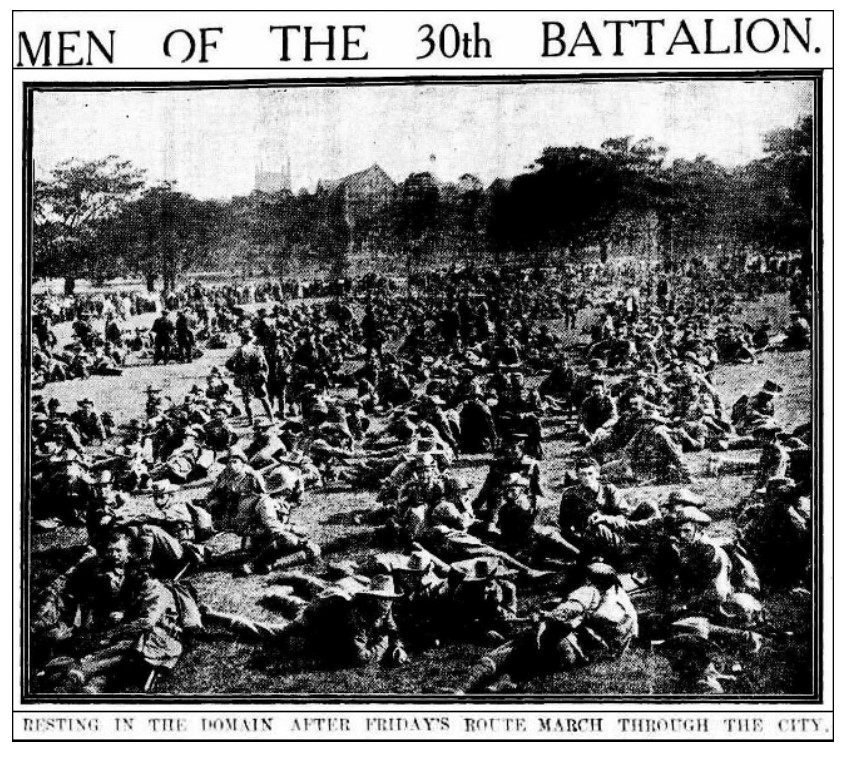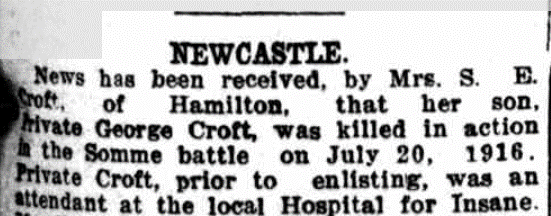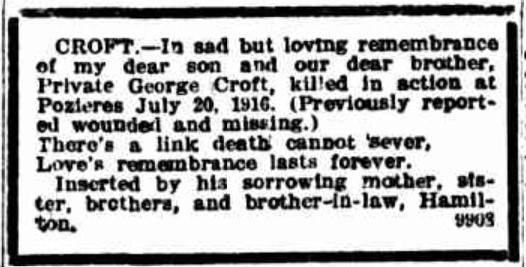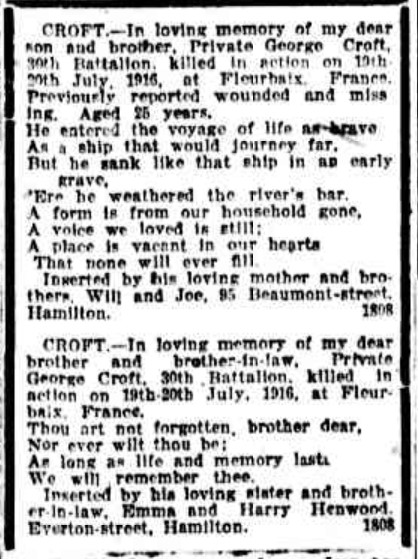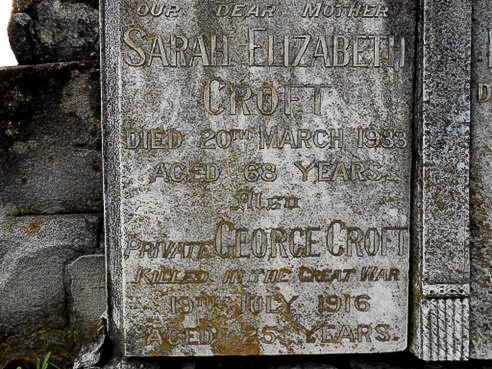George CROFT
Eyes grey, Hair brown, Complexion dark
“I once was lost, but now am found” - The Story of George Croft
George “Darby” Croft was born on the 28th July 1891 in Minmi, NSW, west of Newcastle. George was the third child of Sara Elizabeth (nee Durrant) and Frances Croft. Frances was a miner at the local Seaham Colliery. Unfortunately, he passed away in 1904 at the age of 52, leaving his widow and four children. George’s Grandmother Ann resided with the family during this time, but she passed away in 1908.
George worked as a Hospital Attendant at the Newcastle Mental Hospital, which had approximately 450 patients, the majority of them adults.
Off to War
George enlisted on 10 September 1915 at Newcastle, NSW. He was 24 years old.
The 30th Battalion was raised as part of the 8th Brigade at Liverpool in New South Wales on 5 August 1915. Most of its recruits hailed from the Newcastle region and other parts of country New South Wales:
“NEWCASTLE SOLDIERS. THE 30TH BATTALION.
The 30th Battalion, which has been in camp at Liverpool, and commanded by Lieutenant-Corporal Clark, includes a number of Newcastle men. This battalion forms the New South Wales quota of the 8th Infantry Brigade A.I.F., which will be the next brigade to leave for the front. It is a scattered unit, being made up of the 29th Battalion at Victoria, 30th Battalion, New South Wales; 31st Battalion, Queensland and Victoria (half each), and the 32nd, South Australia and Western Australia. The 30th Battalion has been in existence six weeks, and its total strength of nearly 1100 Includes no fewer than 300 men from Newcastle and district. One company. "B" Company, is composed entirely of Newcastle and district men.”
George left Australia in February 1916 and travelled to Zeitoun, Egypt to join the rest of the battalion and continue his training. Preliminary orders to head to the Western Front came at the end of May and by 17 June the 30th Battalion were aboard the HT Hororata headed for Marseilles. After landing, there was a 60+ hour train ride to Hazebrouck, 30 km from Fleurbaix. They arrived on 29 June and were then encamped in Morbecque. Private F.R. Sharp wrote home:
“From the time we left Marseilles until we reached our destination was nothing but one long stretch of farms and the scenery was magnificent.” “France is a country worth fighting for.”
Training now included the use of gas masks and they also would have heard the heavy artillery from the front lines. On 8 July they were headed towards the front line, first 20 km to Estaires and the next day 11 km to Erquinghem, where they were billeted at Jesus Farm. They got their first ‘taste’ of being in the front lines at 9 PM on 10 July. A week later they got orders for an attack, but it was postponed due to the weather. Two days later, on 19 July, the 29 officers and 927 other ranks of the 30th Battalion went into battle.
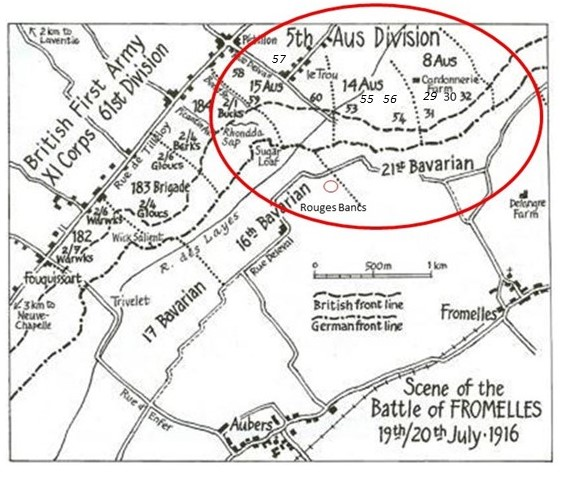
The 30th’s role in the battle was planned to be in support - carrying supplies and ammunition for the 31st and 32nd Battalions who were to lead the attack on the east flank. Machine guns emplacements were to their left and directly ahead at Delrangre Farm and there was heavy artillery fire in No-Man’s-Land.
The 32nd’s charge over the parapet began at 5:53 PM and the 31st’s at 5:58 PM. There were machine guns emplacements to their left and directly ahead at Delrangre Farm and there was heavy artillery fire in No-Man’s-Land. While in a support role and in ‘reserve’, the 30th were soon absorbed into attack as much-needed reinforcements.
When the 30th was formally called to provide fighting support at 10:10 PM, Lieutenant-Colonel Clark of the 30th reported:
“All my men who have gone forward with ammunition have not returned. I have not even one section left.”
Fighting continued through the night. The Australians made a further charge at the main German line, but they were low on grenades, there was machine gun fire from behind from the emplacement at Delangre Farm and they were so far advanced that they were getting shelled by both sides.
At 4:00 AM the Germans began an attack from the Australian’s left flank and by 5:30 AM they attacked from both flanks in force and with bombing parties.
By 10 AM on the 20th, the Germans had repelled the Australian attack and the 30th Battalion were pulled out of the trenches.
Initial figures of the impact of the battle on the 30th were 54 killed, 230 wounded and 68 missing. The ultimate total was that 122 soldiers were either killed or died from wounds and of this total 80 were missing/unidentified.
What Happened to George?
According to witnesses, on the night of the 19th, George was carrying ammunition in support of the 31st/32nd and was at the first German line when he was hit by a shell. A fellow soldier, Frederick Tickner (2171), was beside him when he died.
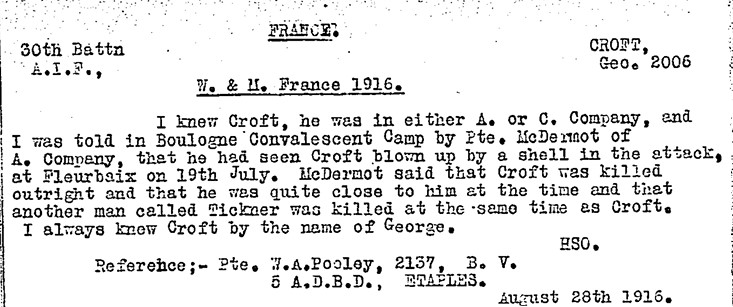
William Augustus Pooley (2137) and his brother 2136 George Joseph Pooley (2136) were also from Wallsend and were both wounded in action at Fromelles. Weston McDermot (2117) went on to win a Military Medal at Morlandcourt in 1918.
A further witness, an unnamed private on "Jan Breydell" H.S. Boulogne, said:
'This man ... was killed on the 19th July at Fromelles during the attack. It happened while he was ammunition carrying. I was behind him, and went off the second time, and saw him dead on the top of the German parapet in the first line of the German trenches. We had to retire back to our own line again and so his body was left behind.'
Several other soldiers confirmed these statements. George was initially reported as Missing in Action. His mother was advised soon after the battle, but only that her son was wounded and missing. While appreciating the difficulties of getting accurate information following the battle, in September 1916 she wrote seeking more of what had happened to her son.
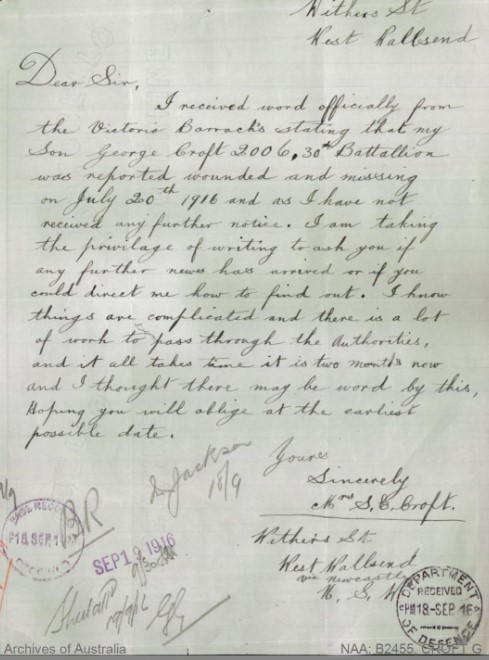
Sadly, no further information about George was able to be provided. Only in 1917 were the family notified as to his death after a Court of Enquiry had deemed him as being Killed in Action.
While there were extensive searches for the missing after the War, George’s body was not found to be able to provide the family with closure. However, he was clearly not forgotten, with memorial notices placed over the next few years, fondly recalling their brother, son and friend.
Closure - George is Finally Found…94 Years Later
An article in the August 23, 2010 Courier Mail written by Alan Lander outlines how George was discovered:
“The temperature was a scorching 32 degrees Celsius that beautiful summer’s day in France, 94 years ago.
But it didn’t stop digger George Croft and the 5th Division AIF from having to plough through knee-deep mud to take on the Germans in the Battle of Fromelles on July 19, 1916, after four days of relentless rain.
George, and nearly 2000 of his mates, stayed there after the battle – seemingly forever – until the recent discovery of a mass grave containing 250 soldiers’ remains brought his memory back into sharp focus for his family.
Leigh Croft of Mooloolah has worked tirelessly to relieve the angst of her long-passed great-grandmother, who never saw the return of her son.
That angst is seared into the pages of letters Leigh has in her possession and which has driven her to successfully establish it was George and AIF volunteers lying in that grave.
When a cousin living in France told Leigh the grave had been found, sparking a journey across the globe to see a deed finally done.
Leigh sent confirming information to the authorities identifying the remains, including male and female family DNA samples.
“It was the mitochondrial female DNA that helped identify him,” she said.
She had established friendly relations with Army contacts during the process then one day they rang her with identity confirmation.
“I knew there could be no other reason to contact me,” she said.
“It’s like I could have won Lotto.”
Leigh had been advised a memorial ceremony had been organised for July this year at Fromelles to honour 205 of the now-identified fallen, and who now occupy Commonwealth graves, side-by-side, mate-by-mate, in the exact order they had been found in the mass tomb.
“I drove to Fromelles the day before the ceremony,” she said.
“I went to VC Corner where a memorial carries all the names and got a picture of George’s name.
“I caught up with the man who found the grave; he was showing the line of trees where the battle was.
“Then I drove round some back-streets and got to within 100 metres of where George died.
“It made it all quite real.”
Leigh said Fromelles was uncannily like Mooloolah: a single T-intersection town centre and a population of about 800.
“Driving in, people seemed to be very proud of the Australian connection; they had toy kangaroos on the gate and flags. It was magical.”
She also journeyed past many other Commonwealth cemeteries, including the massive Villers-Bretonneux Australian national memorial, passing between 40 and 50 in a relatively short drive.
“They were all the same: so quiet, so peaceful. It was eerie,” she said.
She said the ceremony gave her “a huge sense of completion”.
“There was about 6000 people there and a huge number of Aussies.
“What struck me was the waste of life (in the battle), but I was very proud and happy George finally got the headstone.
“I have completed something for my great-grandmother; it’s finally completed.”
George is now interred at the Pheasant Wood Military Cemetery - Plot III, Row D, Grave No 2.
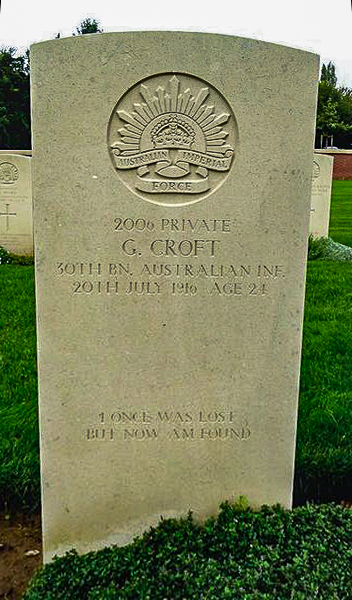
Pheasant Wood Military Cemetery
To date (2024), 26 of the 80 originally unidentified soldiers of the 30th Battalion have been identified and are buried in the Pheasant Wood Cemetery.
George is also commemorated at:
- Australian War Memorial Roll of Honour
- Hamilton (Gregson Park) War Memorial, Book of Gold,
- West Wallsend Superior Public School Roll of Honour,
- West Wallsend Masonic Lodge (St. Andrews No. 198) Roll of Honour,
- West Wallsend Soldiers' Memorial,
- Baulkham Hills William Thompson Masonic School War Memorial,
- Sydney United Grand Lodge Honour Roll
- The Capt. Clarence Smith Jeffries (V.C.) and Pte. William Matthew Currey (V.C.) Memorial Wall.
There’s a link that death cannot sever
Love’s remembrance lasts forever
The Fromelles Association would love to hear from you

Contacts
(Contact: royce@fromelles.info or geoffrey@fromelles.info).
(Contact: army.uwc@defence.gov.au or phone 1800 019 090).
Donations
If you are able, please contribute to the upkeep of this resource.
(Contact: bill@fromelles.info ).
